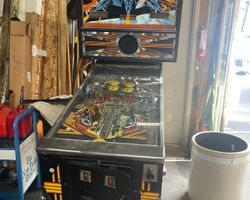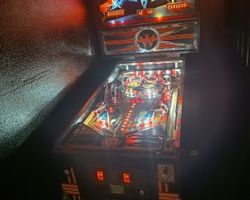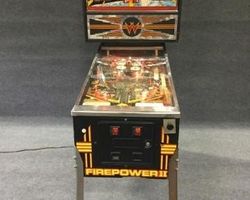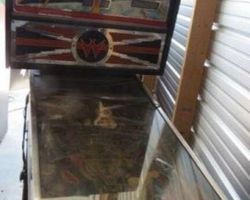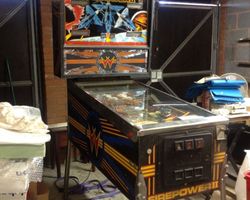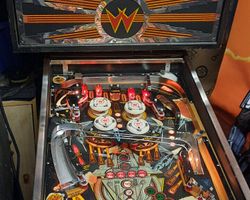Firepower II
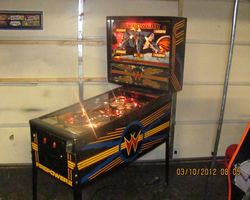
Average Prices: USD $300 to $1,100
Produced: August, 1983
Production Run: 3,400 units
Machine Type: Solid State Electronic
MPU: Williams System 7
Players: 4
Design by: Mark Ritchie
Art by: Constantino Mitchell
The pinball machine Firepower II by Williams Electronic Games, Inc. emerged in June 1983, a pivotal release in the company’s celebrated System 7 era. Following the immense success of its predecessor, Firepower, this machine was tasked with evolving a proven formula while navigating the competitive landscape of early 1980s pinball. Williams, a dominant force in the industry, sought to build on the established popularity of its high-speed, action-oriented designs. Firepower II embraced an outer space theme, a fitting aesthetic for the era and a natural progression from the original's sci-fi martial tone.
The creation of Firepower II involved key talents within Williams. Mark Ritchie, known for his ability to craft engaging layouts, took on the design duties. Eugene Jarvis, whose contributions to pinball sound design are particularly noteworthy, was responsible for the machine's audio experience. The visually striking artwork, central to a machine's appeal, was conceived by Constantino Mitchell and Jeanine Mitchell. Dave Rzepka handled the software, bringing the game's intricate rules and responses to life. With a production run of 3,400 units, Firepower II entered the market as Williams' Model 521, aiming to capture the fast-paced essence of its lineage while introducing new playfield elements. An interesting detail from its production is that the machine utilized excess backboxes from Williams' 1981 Hyperball production, a practical re-use of components that sometimes occurred in manufacturing.
Signature Features and Design
Firepower II distinguishes itself through a combination of its visual presentation and mechanical elements that reinforce its identity. The outer space theme is consistently delivered across the machine, with the backglass and speaker panel artwork receiving particular appreciation for their era-appropriate style and vibrant depiction of interstellar combat. While some observers have noted a slightly unconventional blend of ship designs on the playfield, the overall visual package remains cohesive and contributes to the machine’s thematic immersion.
A standout aspect of Firepower II is its sound design. True to the Williams tradition of the early 1980s, the machine features a rich tapestry of classic electronic effects. These sounds are frequently highlighted as a major draw, immediately transporting players to the heart of 1983 pinball. The distinctive bell sound, triggered by hits on the rollunder spinner and other achievements, serves as a satisfying auditory cue, adding to the game's reward structure. Beyond the audio, the inclusion of a prominent ramp was a notable design choice for a Williams game of this period, attempting to introduce a more modern playfield element and signifying a shift in design philosophy. The captive ball is another mechanical feature, offering a strategic target within the playfield's upper reaches, providing a consistent high-value shot.
Playfield and Mechanics
The playfield of Firepower II is built for velocity, a hallmark of Williams System 7 designs. It features a traditional two-flipper setup at the bottom, providing the primary means of ball control and shot execution. Four pop bumpers are strategically positioned in the upper playfield, maintaining high ball speeds and randomizing returns, keeping players alert. Two slingshots flank the flippers, contributing to chaotic rebounds and rapid-fire action.
A total of ten standup targets are distributed across the playfield, forming crucial objectives. Notably, the arrangement of some of these targets in a curved configuration is designed to manage ball drains, ensuring sustained rallies. The multiball start target, located at the top of the playfield, is accessible from either flipper, offering multiple avenues to initiate the game's signature feature. A single kick-out hole adds another interactive element, often leading to controlled flipper returns.
Central to the playfield's design is the single ramp. While ambitious for its time, its placement and angle make it a challenging shot, often requiring precise aim. Successfully navigating the ball up this ramp can unlock mystery bonuses or higher point values. Below the ramp, a rollunder spinner adds a high-scoring element, rewarding players who can thread the needle through its pathway, often accompanied by the machine's characteristic bell sound. The layout promotes a fast, flowing game, with orbits that allow the ball to loop around the playfield, maintaining momentum. The artwork on the playfield itself complements the space theme with starfields and spacecraft imagery, while the lighting emphasizes active areas, drawing the player's eye to targets and pathways. Even the outlanes incorporate features like rubber posts, designed to mitigate quick, unexpected drains, contributing to a more prolonged and engaging session.
Gameplay Dynamics
Firepower II delivers a gameplay experience characterized by its speed and intensity. The machine's core mechanics revolve around rapid shot sequences and a progression system that encourages aggressive play. The scoring system is straightforward yet strategic, with a particular emphasis on the "Bonus Holdover" feature. This mechanic, highly regarded by players, allows accumulated end-of-ball bonus points to be carried over to the next ball if specific shots are made to light it, creating a compelling objective and a clear path to significant scoring.
The primary objective for many players is to initiate the 2-ball multiball, a signature element of the game. While some contend it is relatively easy to achieve, its accessibility ensures frequent, high-energy sequences. During multiball, players benefit from double scoring, amplifying the excitement and potential for large point totals. This concentrated period of heightened activity demands quick reflexes and precise control to maximize gains.
Despite the machine's flow, certain objectives present distinct challenges. The ramp shot, for instance, is often described as difficult to hit consistently. While it offers mystery bonuses or extra points, its integration into the main objectives of the game is debated, with some finding it a rewarding but isolated shot. The linear "FIREPOWER" sequence, while present, offers a simpler progression compared to the more complex, separate "FIRE" and "POWER" objectives of the original Firepower, leading to a more direct, less layered approach to game advancement. Player strategies often involve focusing on lighting and collecting the bonus holdover, mastering the orbits for continuous flow, and relentlessly pursuing multiball for its scoring multiplier.
Reception and Legacy
Firepower II received a generally positive reception, often earning an average rating that reflects its engaging gameplay. Its strengths frequently cited include its consistently fast and intense gameplay, which keeps players engaged throughout a session. The audio package, featuring the classic and exhilarating Williams sound effects, is almost universally praised as a highlight, contributing significantly to the machine's appeal. The "Bonus Holdover" feature is also lauded as a smart addition, adding strategic depth and replayability. Players appreciate the accessibility of the 2-ball multiball, which, despite being a point of comparison with its predecessor, still delivers thrilling, double-scoring moments. The machine is also often noted for its affordability, making it an attractive option for collectors seeking a classic Williams title.
However, the machine is not without its points of contention. A frequently mentioned drawback is the absence of speech callouts, which were present in the original Firepower and contributed to its character. The decision to implement a 2-ball multiball, as opposed to the 3-ball multiball of the original, also sparked discussions, with some players preferring the added chaos and scoring potential of the latter. The ramp, while an interesting attempt to evolve playfield design, is often criticized for being difficult to hit reliably, sometimes poorly integrated into the overall flow, or not providing sufficient reward for the effort required. Some players also perceive a higher luck factor in Firepower II, particularly concerning ball drains and random ramp bonuses, which can diminish the perceived importance of skill in certain multiplayer contexts. The artwork, while generally good, occasionally receives comments about being less cohesive or appealing than its antecedent.
Despite these criticisms, Firepower II holds a solid place in pinball history. It is often viewed in direct comparison to the original Firepower, with some finding it an improvement due to its refined System 7 technology and updated features, while others refer to it as "Firepower lite," acknowledging its similar yet simplified approach. It represents a significant step in Williams' System 7 lineage, demonstrating the company's continuous efforts to innovate and refine its machines in a rapidly evolving market. Its enduring reputation stems from its pure, unadulterated speed and classic Williams feel, making it a relevant and enjoyable experience for enthusiasts who appreciate the era's design philosophies and the evolution of the pinball machine.
Sponsored Links
 Ebay Listings
Ebay Listings
 Auction Results
Auction Results
| Cost | Location | Date |
|---|---|---|
| USD $670 |  United States United States |
17 September, 2025 |
| USD $1,600 |  New Jersey, United States New Jersey, United States |
05 September, 2025 |
| EUR €899 |  Nordrhein-Westfalen, Germany Nordrhein-Westfalen, Germany |
30 May, 2025 |
| USD $1,750 |  Illinois, United States Illinois, United States |
14 November, 2024 |
| USD $3,700 |  California, United States California, United States |
06 March, 2024 |
| USD $705 |  Ohio, United States Ohio, United States |
13 August, 2023 |
| USD $1,500 |  Kansas, United States Kansas, United States |
28 April, 2023 |
| EUR €1,900 |  Nordrhein-Westfalen, Germany Nordrhein-Westfalen, Germany |
11 December, 2022 |
| USD $1,650 |  Texas, United States Texas, United States |
09 December, 2022 |
| USD $1,600 |  Pennsylvania, United States Pennsylvania, United States |
28 March, 2022 |


Private Policy · Search Website · Contact Us
As an eBay Partner, we may earn a commission from qualifying purchases made through links on this site, at no additional cost to you.
All trademarks and copyrighted materials remain property of their respective owners. All other content copyright 2007 - 2025 Pinpedia.

